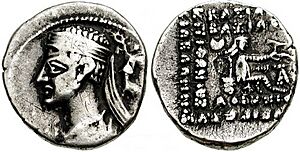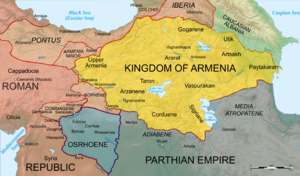Pacorus I facts for kids
Quick facts for kids Pacorus I𐭐𐭊𐭅𐭓 |
|
|---|---|

Coin of Pacorus I, Ecbatana mint
|
|
| King of the Parthian Empire | |
| Reign | c. 39 BC |
| Predecessor | Orodes II |
| Successor | Orodes II |
| Died | 38 BC Cyrrhestica |
| Spouse | Sister of Artavasdes II |
| Dynasty | Arsacid dynasty |
| Father | Orodes II |
| Religion | Zoroastrianism |
Pacorus I (also spelled Pakoros I) was a prince of the Parthian Empire. He was the son and chosen heir of Orodes II, a powerful Parthian king. Some historians believe Pacorus might have ruled alongside his father around 39 BC.
Pacorus was married to an unnamed princess from Armenia. She was the sister of Artavasdes II, who was the king of Armenia at that time.
Pacorus played a big role in the Parthian wars against the Romans. After a major Parthian victory at the Battle of Carrhae in 53 BC, Pacorus led his armies into Roman lands. Even though they had early successes, the Romans eventually pushed them back. Pacorus was defeated and killed in the Battle of Mount Gindarus in 38 BC. His death was a sad event for his father, Orodes II. It led to a struggle for the throne, and Orodes II eventually gave up his crown to another son, Phraates IV.
What's in a Name?
The name Pacorus comes from the Latin language. It's based on the Greek name Pakoros. This name itself comes from an older Iranian word, Pakur. It means 'son of a god'. In Armenian and Georgian, the name is Bakur.
Pacorus's Life and Battles
Pacorus was the oldest son and heir of Orodes II, the ruler of the Parthian Empire. His mother might have been a princess from the eastern parts of Parthia.
Before the famous Battle of Carrhae in 53 BC, Orodes II made a smart move. He invaded Armenia. This cut off the Roman general Marcus Licinius Crassus from his ally, King Artavasdes II. Orodes II also arranged for Pacorus to marry Artavasdes's sister. This created a strong alliance between Parthia and Armenia.
After the Romans were defeated at Carrhae, the Parthians tried to take over Roman lands in Western Asia. Pacorus and his general Osaces attacked Syria in 51 BC. They reached as far as Antioch. However, the Romans, led by Gaius Cassius Longinus, fought back. Cassius ambushed and killed Osaces.
Later, Orodes II supported Pompey in the Roman civil war against Julius Caesar. He even sent troops to help the anti-Caesar forces in 42 BC. A Roman general named Quintus Labienus, who was against the new Roman leaders, joined forces with Parthia in 40 BC. The next year, Labienus and Pacorus invaded Syria together.
The Roman leader Mark Antony could not defend against the Parthians at this time. He had to go back to Italy to deal with his rival, Octavian.
After Pacorus's army took over Syria, Labienus went to invade Anatolia. Pacorus and his general Barzapharnes moved into the Roman Levant. They captured many towns along the Mediterranean coast, except for Tyre. In Judea, the Parthians and their Jewish ally Antigonus II Mattathias defeated the pro-Roman Jewish forces. Antigonus was made king of Judea, while Herod had to flee.
However, the Parthians were soon pushed out of the Levant by a Roman counterattack. Publius Ventidius Bassus, a Roman officer, defeated and killed Labienus in 39 BC. Soon after, Ventidius also defeated another Parthian force in Syria. Because of these defeats, Pacorus temporarily left Syria.
When Pacorus returned in the spring of 38 BC, he faced Ventidius again. This time, they fought at the Battle of Mount Gindarus. Pacorus was killed during this battle. His forces then retreated across the Euphrates River.
Pacorus's death was a great sorrow for his father, Orodes II. It led to a struggle for who would rule next. Orodes II eventually gave the throne to his other son, Phraates IV.
In Literature
A medieval Muslim writer named al-Tha'alibi wrote about Pacorus. He called him Afqūr Shāh. He said that Pacorus found the famous Derafsh-e Kaviani (a legendary Iranian flag). He also wrote that Pacorus led campaigns into Roman lands to get revenge for Alexander the Great's conquest of Persia.
Images for kids
-
Coin of Pacorus I, Ecbatana mint




